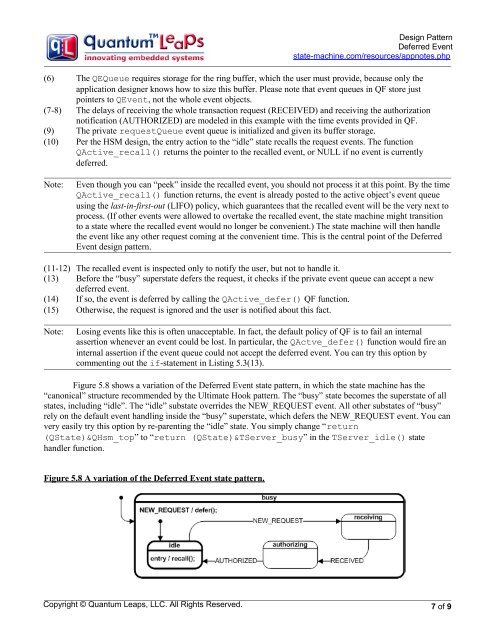Deferred Event - Quantum Leaps
Deferred Event - Quantum Leaps
Deferred Event - Quantum Leaps
You also want an ePaper? Increase the reach of your titles
YUMPU automatically turns print PDFs into web optimized ePapers that Google loves.
Design Pattern<strong>Deferred</strong> <strong>Event</strong>state-machine.com/resources/appnotes.php(6) The QEQueue requires storage for the ring buffer, which the user must provide, because only theapplication designer knows how to size this buffer. Please note that event queues in QF store justpointers to Q<strong>Event</strong>, not the whole event objects.(7-8) The delays of receiving the whole transaction request (RECEIVED) and receiving the authorizationnotification (AUTHORIZED) are modeled in this example with the time events provided in QF.(9) The private requestQueue event queue is initialized and given its buffer storage.(10) Per the HSM design, the entry action to the “idle” state recalls the request events. The functionQActive_recall() returns the pointer to the recalled event, or NULL if no event is currentlydeferred.Note:Even though you can “peek” inside the recalled event, you should not process it at this point. By the timeQActive_recall() function returns, the event is already posted to the active object’s event queueusing the last-in-first-out (LIFO) policy, which guarantees that the recalled event will be the very next toprocess. (If other events were allowed to overtake the recalled event, the state machine might transitionto a state where the recalled event would no longer be convenient.) The state machine will then handlethe event like any other request coming at the convenient time. This is the central point of the <strong>Deferred</strong><strong>Event</strong> design pattern.(11-12) The recalled event is inspected only to notify the user, but not to handle it.(13) Before the “busy” superstate defers the request, it checks if the private event queue can accept a newdeferred event.(14) If so, the event is deferred by calling the QActive_defer() QF function.(15) Otherwise, the request is ignored and the user is notified about this fact.Note:Losing events like this is often unacceptable. In fact, the default policy of QF is to fail an internalassertion whenever an event could be lost. In particular, the QActve_defer() function would fire aninternal assertion if the event queue could not accept the deferred event. You can try this option bycommenting out the if-statement in Listing 5.3(13).Figure 5.8 shows a variation of the <strong>Deferred</strong> <strong>Event</strong> state pattern, in which the state machine has the“canonical” structure recommended by the Ultimate Hook pattern. The “busy” state becomes the superstate of allstates, including “idle”. The “idle” substate overrides the NEW_REQUEST event. All other substates of “busy”rely on the default event handling inside the “busy” superstate, which defers the NEW_REQUEST event. You canvery easily try this option by re-parenting the “idle” state. You simply change “return(QState)&QHsm_top” to “return (QState)&TServer_busy” in the TServer_idle() statehandler function.Figure 5.8 A variation of the <strong>Deferred</strong> <strong>Event</strong> state pattern.Copyright © <strong>Quantum</strong> <strong>Leaps</strong>, LLC. All Rights Reserved.7 of 9
















